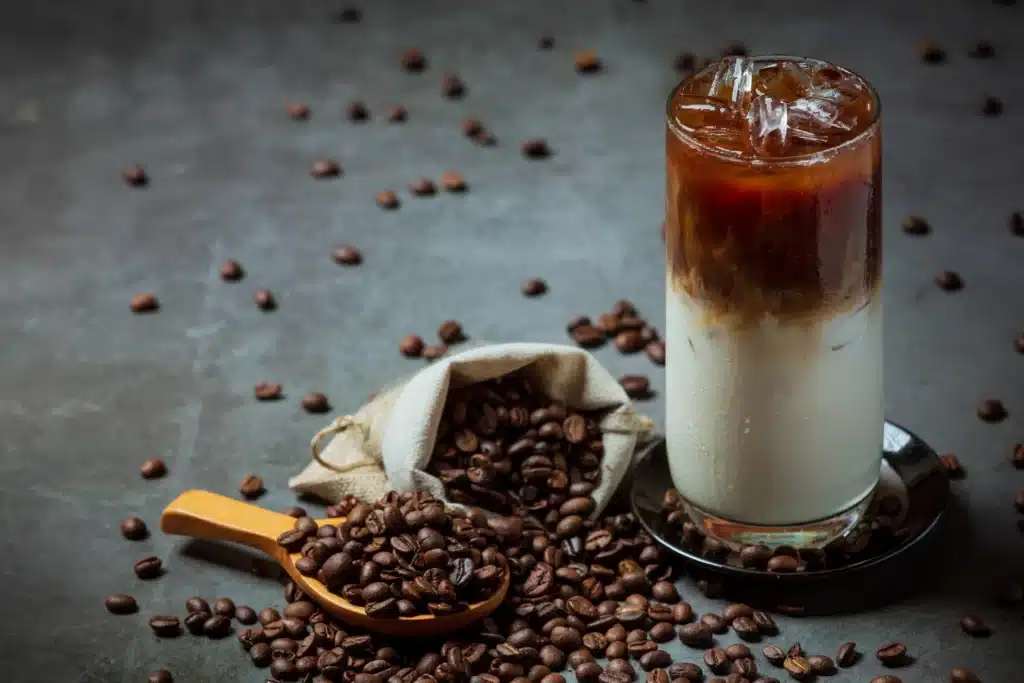
Iced coffee is more than just a popular warm-weather treat; it’s a refreshing beverage that has gained a devoted following worldwide. Many coffee lovers appreciate the stimulating combination of caffeine and chill, and making your perfect iced coffee at home is easier than you might think. In this blog post, we will explore the world of iced coffee, from the importance of selecting high-quality coffee beans to various brewing methods, perfecting the brew, sweeteners and flavorings, and serving techniques. We’ll also dive into popular iced coffee variations and offer troubleshooting tips to ensure your home-brewed iced coffee experience is flawless.
But before we delve into the details of creating your ideal iced coffee, let’s begin with the cornerstone of any great cup: the coffee beans.
Choosing the Right Coffee Beans
The journey to crafting the perfect iced coffee starts with selecting the right coffee beans. Quality beans are the foundation of any outstanding coffee, and the same applies to your iced version. Here are some key points to consider when choosing your coffee beans for iced coffee:
- Significance of Bean Selection: The coffee beans you choose significantly impact the flavor and aroma of your iced coffee. Whether you prefer a bold, full-bodied taste or a more delicate and nuanced profile, selecting the right beans is crucial.
- Coffee Bean Types: There are various types of coffee beans, each with its own unique flavor profile. The most common varieties are Arabica and Robusta. Arabica beans tend to be more aromatic and have a smoother taste, while Robusta beans are known for their bold, slightly bitter flavor. Other specialty beans like Ethiopian Yirgacheffe or Kenyan AA offer distinct flavor notes that can elevate your iced coffee.
- Sourcing and Storage: Consider where and how you source your coffee beans. Local roasters, specialty shops, or even online sources can provide a wide range of options. To preserve freshness, store your beans in an airtight container in a cool, dark place. Avoid keeping them in the freezer, as moisture can degrade the flavor.
- Recommendations: While personal taste plays a significant role in bean selection, some beans are particularly well-suited for iced coffee. Look for beans with a well-balanced flavor, like a medium or medium-dark roast, as they often provide a satisfying base for your chilled creation.
Now that you’ve chosen your coffee beans, let’s explore the brewing methods that can transform them into a delightful iced coffee.
Brewing Methods
There are several brewing methods suitable for making iced coffee, each imparting unique characteristics to the final brew.
- Cold Brew: Cold brew is renowned for its smooth and less acidic profile. To make cold brew, coarsely ground coffee beans are steeped in cold water for an extended period, usually 12-24 hours, and then strained. The result is a concentrated coffee base that can be diluted with water, milk, or a milk alternative before serving over ice.
- Pour-Over: Pour-over coffee involves pouring hot water over coffee grounds in a filter, allowing the coffee to drip into a carafe or cup. This method offers control over the brewing process, enabling you to adjust the strength of your brew to your preference.
- Espresso-Based Methods: Espresso-based iced coffee drinks like lattes, Americanos, and macchiatos can be created by pulling shots of espresso over ice and then adding water, milk, or syrups to customize the flavor.

Each method has its pros and cons, providing a range of options for your perfect iced coffee experience. Experimenting with different methods allows you to discover the one that best suits your taste.
Perfecting the Brew
Achieving the perfect iced coffee involves attention to detail at every step of the brewing process.
- Water Quality and Temperature: The quality of the water significantly impacts the flavor of your coffee. Opt for filtered or bottled water to ensure a clean taste. Additionally, water temperature during brewing should be between 195-205°F (90-96°C) for optimal extraction.
- Coffee-to-Water Ratio: Balancing the coffee-to-water ratio is crucial. A general guideline is 1:15, meaning one part coffee to 15 parts water. Adjusting this ratio allows you to control the strength of your brew.
- Grind Size and Brewing Time: The grind size of your coffee beans affects the brewing time. For cold brew, a coarse grind is ideal, while methods like pour-over and espresso require specific grind sizes for the best results. Experimentation is key to finding the perfect grind for your chosen brewing method.
Sweeteners and Flavorings (Optional)
Customizing your iced coffee with sweeteners and flavorings adds depth and complexity to your beverage. Popular choices include sugar, syrups, and spices. For a healthier option, natural sweeteners like honey or agave syrup can be used. Experiment with different flavors, such as vanilla, caramel, or cinnamon, to find your signature iced coffee blend.
Cooling and Serving
Once your coffee is brewed, the cooling and serving process is vital to preserving its flavors.
- Cooling Process: Pour your freshly brewed coffee over ice cubes or use coffee ice cubes made by freezing brewed coffee in an ice tray. This prevents dilution as the ice melts.
- Glassware and Presentation: Choosing the right glassware enhances the visual appeal of your iced coffee. Tall glasses or mason jars are popular choices. To elevate your presentation, garnish your drink with a sprinkle of cocoa powder, a cinnamon stick, or a twist of citrus peel.
Iced Coffee Variations
Iced coffee is a canvas for creativity, inviting you to experiment with a variety of flavors and textures. Here, we explore some popular and delectable iced coffee variations that can elevate your coffee experience to new heights.
- Iced Coffee with Milk or Cream: One of the classic variations, adding milk or cream to your iced coffee provides a creamy and indulgent touch. Whether you prefer whole milk, almond milk, or a rich dollop of cream, the added dairy creates a smooth, mellow flavor, balancing the coffee’s natural bitterness. Stir gently to blend the flavors seamlessly.
- Iced Coffee with Whipped Cream: For those seeking a touch of luxury, topping your iced coffee with a generous swirl of whipped cream transforms it into a decadent treat. The creaminess of the whipped topping combines with the cold coffee, offering a delightful contrast in both texture and temperature.
- Iced Coffee with Flavored Syrups: Flavored syrups are a delightful way to infuse your iced coffee with unique tastes. Vanilla, caramel, hazelnut, or even seasonal flavors like pumpkin spice can be added in syrup form. Start with a small amount, taste, and adjust until you achieve your desired level of sweetness and flavor. Syrups not only sweeten your drink but also impart aromatic and nuanced notes.
- Iced Coffee with Ice Cream: For an indulgent dessert-like experience, consider adding a scoop of your favorite ice cream to your iced coffee. The creamy, melting ice cream blends with the cold coffee, creating a luscious concoction reminiscent of an affogato. Popular choices include vanilla, chocolate, or even caramel swirl ice cream, each adding a unique twist to your beverage.
- Iced Coffee with Condensed Milk: Inspired by Vietnamese iced coffee, using condensed milk imparts a rich sweetness and a velvety texture to your drink. The condensed milk’s caramelized notes complement the coffee’s bold flavor, creating a harmonious blend. Adjust the amount of condensed milk to suit your sweetness preference, and stir thoroughly to incorporate it evenly.
- Iced Coffee with Flavored Ice Cubes: Elevate your presentation and flavor profile by freezing coffee into ice cubes. These coffee ice cubes melt slowly, ensuring your drink remains chilled without becoming watered down. Additionally, you can infuse the ice cubes with complementary flavors, such as adding a hint of cinnamon, vanilla, or even a splash of flavored syrup before freezing.
- Iced Coffee Float: Similar to a root beer float, an iced coffee float involves pouring your brewed coffee over a scoop of vanilla or coffee-flavored ice cream. As the coffee blends with the melting ice cream, it creates a harmonious balance of bitterness and sweetness, making for a delightful dessert-like treat.
- Iced Coffee with Coconut Milk: Coconut milk adds a tropical twist to your iced coffee. Its natural sweetness and subtle coconut flavor complement the coffee beautifully. Whether you use regular or light coconut milk, the result is a creamy, dairy-free alternative that’s both refreshing and exotic.
- Iced Coffee with a Dash of Spice: Experiment with spices like cinnamon, cardamom, or nutmeg to add depth and warmth to your iced coffee. Simply sprinkle a pinch of your chosen spice on top of your drink or infuse it directly into the coffee grounds before brewing. The aromatic spices transform your ordinary iced coffee into a fragrant and enticing beverage.

Troubleshooting Tips
Mastering the art of making iced coffee involves overcoming challenges and fine-tuning your brewing process. Here are some common issues that coffee enthusiasts encounter and practical troubleshooting tips to help you achieve a flawless iced coffee every time.
Issue: Bitter Coffee
Solution: Bitterness often results from over-extraction, where the coffee grounds are in contact with water for too long or the grind size is too fine. To counteract bitterness, consider the following:
- Adjust Brewing Time: Shorten the brewing time, especially for methods like pour-over or espresso. Experiment with different time intervals until you find the sweet spot for your taste buds.
- Coarser Grind: Opt for a coarser coffee grind, especially for methods like French press or cold brew. A coarse grind reduces the extraction rate, resulting in a smoother, less bitter brew.
- Water Temperature: Ensure your water temperature is within the optimal range of 195-205°F (90-96°C). Water that is too hot can extract undesirable compounds from the coffee, leading to bitterness.
Issue: Weak Coffee
Solution: If your iced coffee lacks depth and flavor, it might be under-extracted. Try the following techniques to strengthen your brew:
- Increase Coffee-to-Water Ratio: Use more coffee grounds to water to create a stronger brew. Experiment with ratios until you find the right balance. The standard ratio is 1:15 (coffee to water), but you can adjust this to suit your preference.
- Finer Grind: For methods like espresso or AeroPress, a finer grind increases extraction. Experiment with slightly finer grinds until you achieve a stronger flavor.
- Extended Brewing Time: If you’re making cold brew, consider extending the steeping time. Cold brew coffee typically requires a longer brewing period (12-24 hours) to extract flavors fully.
Issue: Cloudy Appearance
Solution: A cloudy appearance in your iced coffee can be due to fine coffee particles. To clarify your brew, try these methods:
- Use Coarser Filters: If you’re using a French press or pour-over method, switch to coarser filters to trap larger particles and create a clearer coffee.
- Double-Filtering: After brewing, strain your coffee through a paper filter or fine-mesh sieve to remove tiny particles. This additional step can significantly enhance clarity.
Issue: Unbalanced Flavors
Solution: If your iced coffee lacks balance, it might be due to uneven extraction. Follow these steps to achieve a harmonious flavor profile:
- Stir Thoroughly: After brewing, stir your coffee well to ensure even distribution of flavors. Concentrated compounds tend to settle at the bottom, so a good stir before serving can make a difference.
- Adjust Grind Size: Experiment with different grind sizes based on your brewing method. Finer grinds can intensify flavors, while coarse grinds can mellow the taste.
- Explore Different Coffee Beans: Different coffee beans have distinct flavor profiles. Experiment with beans from various regions to find one that complements your preferred brewing method.
Conclusion
In conclusion, crafting the perfect iced coffee at home is a delightful journey of experimentation and creativity. By understanding the nuances of coffee beans, exploring various brewing methods, and embracing unique flavor combinations, you can enjoy a customized iced coffee experience tailored to your taste.
As you embark on this flavorful adventure, remember that the key lies in your passion for quality ingredients and a willingness to explore. Invite your friends and family to join you on this iced
coffee expedition, sharing the joy of a well-brewed cup that refreshes not just your body but also your spirit.
Now that you have the knowledge and tools at your disposal, go forth and create your perfect iced coffee masterpiece. Happy brewing!
